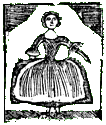Rev. Richard Mosley and the Boylston-Molineux Marriage
Mosley’s presence may help in the quest to answer one of the vexing genealogical mysteries of pre-Revolutionary Boston.
According to family historians, Mosley was the minister who married Ward Nicholas Boylston to Ann Molineux. The ceremony reportedly took place on the Salisbury while it was in Portsmouth harbor, with a special license from New Hampshire governor John Wentworth.
Since Boylston was the son of Benjamin Hallowell, Jr., a Customs Commissioner, and Molineux was the daughter of William Molineux, one of Boston’s most radical anti-Crown activists, their marriage raises lots of questions. Mosley’s presence doesn’t help to answer the question of why. But it may help to answer the question of when, or at least narrow down the window.
H.M.S. Salisbury arrived in Boston harbor on the morning of 10 Oct 1770, as reported in the newspapers and the diary of John Rowe. It sailed for Britain at the end of August 1771. We have glimpses of the commodore in command of the ship, James Gambier, and chaplain Mosley in Boston in the intervening months:
- 10 Dec 1770: While in Boston harbor, Cmdre. Gambier signed a proclamation about deserters printed in the Boston News-Letter and other papers.
- 28 Jan 1771: Gambier and his wife had a baby daughter baptized at King’s Chapel with Lt. Gov. Thomas Hutchinson, Lady Agnes Frankland, and Ann Burch, wife of a Customs Commissioner, as sponsors.
- 8 February: Gambier signed another proclamation, also in Boston harbor.
- 9 March: Rowe wrote in his diary, “The Chaplain Mr. Mossely of the Salisbury was taken in an Apoplectick fit yesterday which hindered him coming to our house.”
- 14 March: Gambier presided over the firing of cannon to salute new royal appointments.
- 2 April: Rowe saw both Gambier and Mosley at a dinner for a charitable society.
- 29 May: Gambier attended the opening of the legislative session at Harvard College.
- 4 June: Gambier hosted a ball that Rowe attended.
- 21 June: Gambier dined at Ralph Inman’s house in Cambridge.
- 6 August: Gambier entertained Boston’s elite on the Salisbury.
Notably, the first child of the Boylstons’ marriage, young Nicholas, arrived before the end of 1771. So maybe we learn a little about the why as well.
COMING UP: Mr. Mosley’s North American career.


